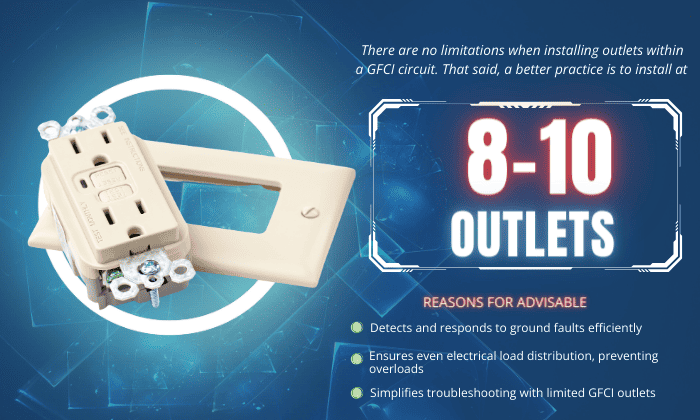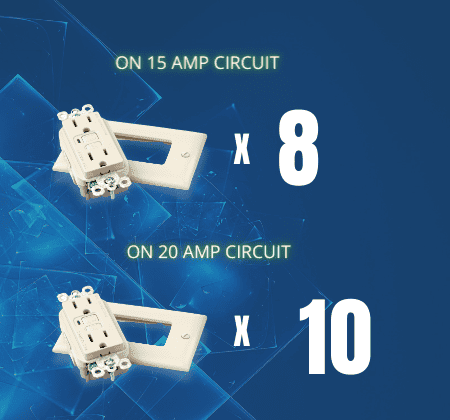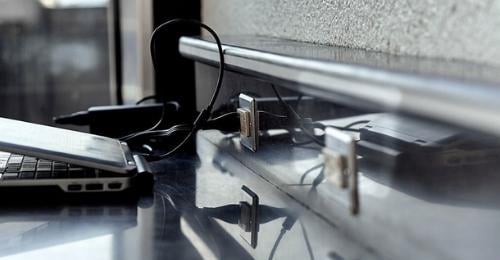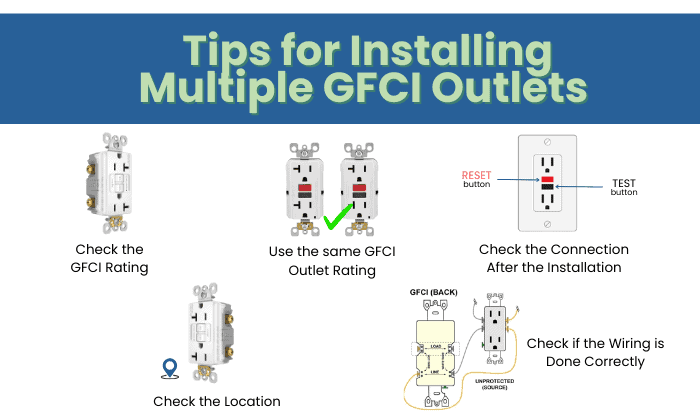Ground Fault Circuit Interrupters, or GFCIs, are indispensable for ensuring the safety of every household, particularly in areas where water is present. These devices are a crucial defense against ground faults within our home’s electrical circuits.
However, have you ever asked yourself, “How many outlets can a GFCI protect?”
Many experts assert that there are no limitations when installing outlets within a GFCI circuit. That said, a better practice is to install at most 10 outlets. Let us clarify this below.
Table of Contents
Max Number of Outlets on a GFCI Circuit
When it comes to installing outlets, the NEC standard states that there are no limits for an outlet installation in a circuit.
However, it does not mean you can freely install as many as you want. Plugging excessive outlets in a single circuit increases the risk of overloading.
In practice, limiting your receptacles installation to a range of 8 to 10 outlets is advisable due to the reasons below:
- This allows the breaker to detect and respond to ground faults effectively.
- It also helps distribute electrical loads more evenly within the circuit, reducing the likelihood of overloads and ensuring reliable performance.
- Having a restricted number of GFCI protected outlets simplifies the troubleshooting process for ground fault issues, making it easier to identify and address problems when they arise.
Factors Affect the Outlets Number
To determine how many outlets you should install in a circuit, several crucial factors should be considered:
1. Load for Every Outlet
The power requirement of each outlet, often expressed in amps, is critical in calculating the circuit’s safe number of outlets. A common recommendation is to allocate 1.5 amps per GFCI current limit.
Moreover, we also need to consider the 80% rule in electrical circuits for safety. So, the total amps of all connected outlets should not exceed 80% of the circuit breaker.
As a result, it is best to limit the number of outlets to no more than 8 on a 15-amp circuit and up to 10 on a 20 amp circuit.
2. Circuit Distance
The circuit’s voltage drop is affected by the length of electrical wiring and the distance between the outlets and the circuit breaker panel.
Longer lengths might cause higher voltage losses, restricting the number of outlets that can be appropriately powered without compromising safety and performance.
3. Appliance Load
The power requirements of electrical appliances and gadgets connected to outlets in a circuit vary.
You must ensure that a GFCI can handle the load of the appliances, as some devices may require dedicated outlets, which means that no more outlets can be connected to the same circuit to avoid overloading.
Tips for Installing Multiple GFCI Outlets on One Circuit
Following the tips below will help you safely and effectively install multiple outlet on a single circuit, enhancing electrical safety in your home or workplace. However, it’s worth noting that you don’t typically need multiple GFCI outlets on the same circuit.
For comprehensive ground fault protection, consider installing a GFCI circuit breaker. Alternatively, you can use a single GFCI outlet and connect multiple standard outlets downstream, as they will all benefit from GFCI protection.
1. Check the GFCI Rating
When installing a GFCI outlet in series, you should consider installing only the correct amperage rating for your circuit. Using outlets with a higher rating might result in safety hazards and noncompliance with electrical codes.
2. Use the Same GFCI Outlet Rating
Ensure consistency in the amperage rating of the GFCI outlets you plan to install on a single circuit. Mixing outlets with different amperage ratings can lead to complications and may not provide uniform protection.
3. Check the Location
GFCI is essential for specific locations where there is a higher risk of electrical shocks or where moisture is present, such as bathrooms, kitchens, garages, and outdoors.
Following this practice provides more protection against ground faults in areas where they are most likely to occur.
4. Check if the Wiring is Done Correctly
Make sure that the hot (black or red), neutral (white), and ground (green or bare) wires are properly connected to the GFCI outlets. Any wiring mistakes can reduce the effectiveness of the GFCI protection.
5. Check the Connection After the Installation
After installing the GFCI outlets, test them to ensure they are working properly. To trip the GFCI and turn off the power, press the “Test” button on each outlet. Then, to restore power, press the “Reset” button.
If any outlet fails to trip or reset as planned, examine the problem as soon as possible to ensure the outlets are delivering the desired ground fault protection.
Conclusion
In conclusion, understanding how many outlets can a GFCI protect is crucial for ensuring electrical safety. Limiting the number of outlet installations inside a circuit is a good way to avoid overloading.
Remember that even if the NEC code does not specify the number of outlets that can be installed in their jurisdictions, it is still advisable to establish limitations.
Setting acceptable constraints on outlet numbers will ensure your safety and act as an excellent technique for maintaining electrical security within your circuits.

I am Andrew Wright. With 8 years of experience designing, installing, and maintaining electrical power systems. I love my job, and I have always wanted to offer others the necessary help so they can take care of their houses.






